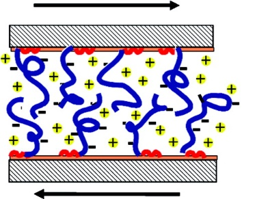Using SAXS we were able to resolve the manner by which bottlebrush block copolymers assemble with nanoparticles (Macromolecules 2019), the structure of hydrophobically controlled adaptive crystaline films made of block copolymers (Angewandte Chemie 2018), the nematic liquid crystalline phases of cellulose-spider silk bio-nanocomposites comprised of cellulose nanocrystals and recombinant spider silk protein fused to a cellulose binding domain (Int. J. Mol. Sci. 2016), the strcuture of copper sulfide nanocrystal arrays (Nano Lett. 2014), the tilted arrangement of cellulose in stork's bill awn (Journal of The Royal Society Interface 2011), and the organization of nanoparticles (Journal of colloid and interface science 2010, Colloids and Surfaces A: Physicochemical and Engineering Aspects 2010).
Surface force experiments on highly compressed, polyelectrolyte brushes in aqueous media, revealed a remarkable lubricity which is in a large measure attributed to the hydration layers about the charged polymer segments: This water of hydration strongly resists being squeezed out, but at the same time it may rapidly exchange with adjacent water molecules, thereby remaining quite fluid and acting as a molecular lubricant. We also showed that the frictional forces between other polymer modified surfaces: adsorbed (charged or neutral) polymers or neutral polymer brushes, were significantly higher than those across polyelectrolyte brushes, showing that both the hydrated ions and the brush configuration are important. This study provides insight into the principles of biolubrication (Nature 2003 and other relevant publication).


